Cambrian
Madusae Jellyfish Fossils
from
Blackberry Hill, Elk Mound Group, Wisconsin
The
Cnidarians
"Fiercest
Predators of the Cambrian"
Stranded on a Cambrian Shoreline
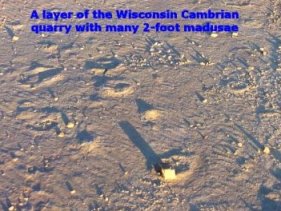 Near
a sleepy rural burg named Mosinee Wisconsin is a flagstone quarry
that outcrops the Mount Simon
Wonewoc Sandstone, Elk Mount Group, that may help fill in
some pieces in the Cambrian puzzle. Among the fossils and trace
fossils found in the Krakowski quarry are numerous circular
impressions in layers of rippled sandstone where once was a
shallow tropical seashore during the Cambrian. In the February
2002 issue of Geology, Hagadorn, Dott and Damrow publish a paper
titled: "Stranded on a Late
Cambrian shoreline: Medusae from central Wisconsin".
The implications are of some note to paleontology since such
huge jellyfish were likely one of the fiercest predators in
the early Paleozoic. According to Hagadorn, the jellies from
the Mosinee quarry are not just large for the Cambrian, but
are the largest jellyfish in the entire fossil record. The quarry
contains different layers with densely populated impressions
the likely result of a mass-stranding of groups of madusae on
a Paleozoic shoreline. Such strandings frequently still occur
on Earth, but in the Cambrian there were no land predators.
The
Near
a sleepy rural burg named Mosinee Wisconsin is a flagstone quarry
that outcrops the Mount Simon
Wonewoc Sandstone, Elk Mount Group, that may help fill in
some pieces in the Cambrian puzzle. Among the fossils and trace
fossils found in the Krakowski quarry are numerous circular
impressions in layers of rippled sandstone where once was a
shallow tropical seashore during the Cambrian. In the February
2002 issue of Geology, Hagadorn, Dott and Damrow publish a paper
titled: "Stranded on a Late
Cambrian shoreline: Medusae from central Wisconsin".
The implications are of some note to paleontology since such
huge jellyfish were likely one of the fiercest predators in
the early Paleozoic. According to Hagadorn, the jellies from
the Mosinee quarry are not just large for the Cambrian, but
are the largest jellyfish in the entire fossil record. The quarry
contains different layers with densely populated impressions
the likely result of a mass-stranding of groups of madusae on
a Paleozoic shoreline. Such strandings frequently still occur
on Earth, but in the Cambrian there were no land predators.
The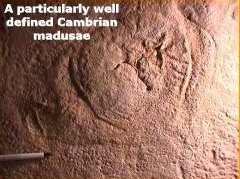 fossils exhibit features nearly identical to those observed
in modern scyphozoan jellyfish strandings. Some event in the
absence of shore erosion may have enabled the stranded jellyfish
to be buried and thus allow these fossil imprints to be formed.
fossils exhibit features nearly identical to those observed
in modern scyphozoan jellyfish strandings. Some event in the
absence of shore erosion may have enabled the stranded jellyfish
to be buried and thus allow these fossil imprints to be formed.
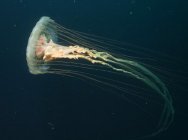 It
was during the Cambrian that animals with hard shells first
appeared, enabling a rich fossil record to begin. Trace fossils
such as these soft-bodied jellyfish are exceedingly rare. The
Medusae jellyfish fossils have so far been found in seven layers
in the quarry, representing some 12 vertical feet of rock and
corresponding to a span of time of about one million years.
Hagadorn, et. al., state that the quarry's features are "consistent
with an intermittently exposed intertidal and shallow-subtidal
setting that was probably located in a shallow lagoonal area
with limited wind fetch . . . . within a possible sandy barrier
island system on the flank of the Wisconsin dome may have further
restricted the environment, and severe tropical storms provide
a plausible mechanism for Medusoid stranding. Hagadorn also
points out: “These jellyfish are not just large for the
Cambrian, but are the largest jellyfish in the entire fossil
record. What is also of interest is that they were among the
largest two types of predators in the Cambrian.” The medusae
were stranded atop and capped by a variety of bedforms. Fossils
are epirelief and hyporelief
impressions.
It
was during the Cambrian that animals with hard shells first
appeared, enabling a rich fossil record to begin. Trace fossils
such as these soft-bodied jellyfish are exceedingly rare. The
Medusae jellyfish fossils have so far been found in seven layers
in the quarry, representing some 12 vertical feet of rock and
corresponding to a span of time of about one million years.
Hagadorn, et. al., state that the quarry's features are "consistent
with an intermittently exposed intertidal and shallow-subtidal
setting that was probably located in a shallow lagoonal area
with limited wind fetch . . . . within a possible sandy barrier
island system on the flank of the Wisconsin dome may have further
restricted the environment, and severe tropical storms provide
a plausible mechanism for Medusoid stranding. Hagadorn also
points out: “These jellyfish are not just large for the
Cambrian, but are the largest jellyfish in the entire fossil
record. What is also of interest is that they were among the
largest two types of predators in the Cambrian.” The medusae
were stranded atop and capped by a variety of bedforms. Fossils
are epirelief and hyporelief
impressions. 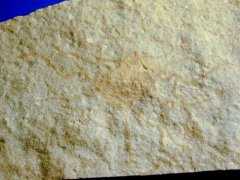 Sediment
contained within the gastric cavity and attached to oral arms
and lappets is preserved in full relief. Radial canals, long
oral arms, and reduced tentacles associated with umbrella-shaped
impressions, coupled with medusae size and lack of ring canal
impressions, suggest a similarity to extant scyphomedusae jellyfish.
Sedimentologic data support the theory that the medusae horizons
are event beds deposited during major
Sediment
contained within the gastric cavity and attached to oral arms
and lappets is preserved in full relief. Radial canals, long
oral arms, and reduced tentacles associated with umbrella-shaped
impressions, coupled with medusae size and lack of ring canal
impressions, suggest a similarity to extant scyphomedusae jellyfish.
Sedimentologic data support the theory that the medusae horizons
are event beds deposited during major 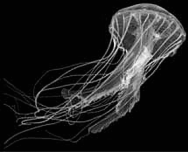 storm
surges, rather than time-averaged accumulations.
storm
surges, rather than time-averaged accumulations.
Yet
another layer of the quarry yields jellyfish that are smaller,
but have tenacles in the familiar radial symmetry of Cnidarians,
as shown in the picture. Jellyfish were some of the most ferocious
preditors of the Cambrian marine environment, and may well have
munched on the arthropods that left the arthropod trackways
known as Diplichnites and Protichnites
that are also abundantly found in the quarry.
References



 Sediment
contained within the gastric cavity and attached to oral arms
and lappets is preserved in full relief. Radial canals, long
oral arms, and reduced tentacles associated with umbrella-shaped
impressions, coupled with medusae size and lack of ring canal
impressions, suggest a similarity to extant scyphomedusae jellyfish.
Sedimentologic data support the theory that the medusae horizons
are event beds deposited during major
Sediment
contained within the gastric cavity and attached to oral arms
and lappets is preserved in full relief. Radial canals, long
oral arms, and reduced tentacles associated with umbrella-shaped
impressions, coupled with medusae size and lack of ring canal
impressions, suggest a similarity to extant scyphomedusae jellyfish.
Sedimentologic data support the theory that the medusae horizons
are event beds deposited during major  storm
surges, rather than time-averaged accumulations.
storm
surges, rather than time-averaged accumulations.